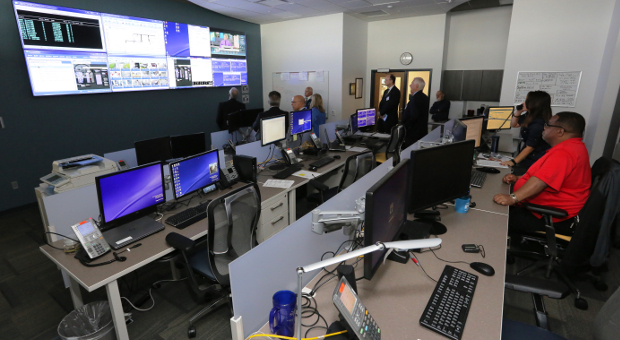Transition underway to new University Technology Center

A new data center providing centralized, secure space for patient, research and educational data from Penn State Health Milton S. Hershey Medical Center and Penn State College of Medicine is now online.
Officials gathered this morning to dedicate the 46,000-square-foot University Technology Center, which supports both the growing health system and the region's medical school. Twenty-nine employees work at the new facility, which is staffed around the clock.
The process of moving data from the previous data center began in April and is expected to finish by early 2017.
“Although we're standing in front of a new data center and not a new clinic or hospital unit, today marks an important milestone in patient care,” said Dr. Andrew Resnick, the Medical Center's chief quality officer. “Good data used properly can and will inform and improve the care we give.”
INFOGRAPHIC: University Technology Center – By the Numbers
In addition to secure storage, the University Technology Center houses powerful computers and data storage devices for analyzing information. This includes the bio-repository of patient samples from the Penn State Institute for Personalized Medicine. The Institute uses highly specialized tools for genetic testing and analysis of these samples, and to prepare them for genomic sequencing.
“The new data center will enhance our efforts by making personalized medicine more of a reality for patients and their providers,” said Jim Broach, director of the Penn State Institute for Personalized Medicine and chair of the Department of Biochemistry and Molecular Biology. “Data that may take days, weeks or even months to analyze now may soon be processed in a matter of minutes or hours.”
“State-of-the-art, high performance computing and big data storage are essential at any research-intensive university, and I'm proud that Penn State is moving aggressively to ensure that the future is even more robust than the past,” said Penn State President Eric Barron.
As the back-up location for Penn State's primary data center, the University Technology Center will serve an integral role in the University's disaster recovery plan. Likewise, the University Park data facility will serve as a backup for Hershey's data center. The fiber optic network connection between Hershey and University Park will have a bandwidth of 100 gigabits per second – approximately 5,000 times the average home internet connection.
The University Technology Center uses one megawatt of power – roughly the equivalent of 92 average U.S. households. The facility has 768 batteries that provide an extra layer of back-up beyond the building's two main power feeds. Its power usage is offset by various energy-saving components designed to eliminate waste and improve efficiency. They include:
- a cooling system which is expected to operate free of conventional air conditioning for 86 percent of the year, despite the heat generated by the more than 1,000 servers that will be housed in the Center.
- measures incorporated into the center's design that are expected to result in the use of at least 60 percent less power for critical systems than typical data centers.
- Leadership in Energy and Environmental Design (LEED) certification.
EDITORS: This photo gallery contains high-resolution photos available for download:
More about the University Technology Center:
- Learn about how the new Center builds on promises that date back to the College of Medicine's groundbreaking 50 years ago in this Penn State Medicine article.
- Learn more about the new facility in this article about the January, 2015 groundbreaking.
- Take a virtual tour of the new Center.
If you're having trouble accessing this content, or would like it in another format, please email Penn State Health Marketing & Communications.

